Copyright ©2006 PopEntertainment.com. All rights reserved.
Posted:
September 9, 2006.
The lure of Hollywood is a seductive one – a siren’s call promising fame,
money, love and power. People travel many miles, endure great hardships,
work demeaning jobs and face incredible competition – all in the quest to
capture the glimpse or possibility of stardom.
It
is almost a cliché now for an actor or actress to trek to endless
auditions long after hope of “the big break” has been extinguished. It is
almost unheard of for someone in the early phases of a promising career to
suddenly just walk away.
This brings us to Melissa Greene.
Greene is the child of show biz parents. If you know anything about
Hollywood, you know that very few people actually are from
there. Greene is one of those rare natives. Her mother was model and
actress Jan Wiley, best known as Dick Tracy's girlfriend in the original
1930s serial, as well as for small roles in Stagedoor, So
Proudly We Hail, The Best Years of Our Lives, and the classic
Citizen Kane. Her father, Mort Greene, was a longtime Red
Skelton Show staff writer. He was also a celebrated lyricist,
composing the words to “Stars in Your Eyes,” “Weary Blues” and “The Toy
Parade,” which became the theme to Leave It to Beaver. He was
nominated for an Academy Award in 1946 for “There’s a Breeze on Lake
Louise” from the film The Mayor On 44th Street.
“My father was multi-talented,” Greene says. “He was a cartoonist, played
piano, wrote lyrics and ended up writing comedy for Red Skelton. He was
also a wizard at self-promotion. And he loved to tell jokes – my
father was ‘onstage’ when he picked up his clothes at the cleaners!”
Greene inherited that gift for self-promotion. Or, more to the point, she
so wanted to be like her father that she emulated him. “I studied the
bold, zany way he presented himself to the world, then I did the same
thing… whether it was me or not.” Over the years, she mirrored the
careers of both of her parents, becoming a model, actress and songwriter.
In
the early 1970s, it appeared that Greene had the stuff of stardom. She
broke from the pack of unknown actresses by making herself “highly present
and conspicuous” at every audition, acting class, or studio
commissary. She regularly wrote notes to producers, on her letterhead,
explaining why they should hire her for a role in their show or film.
During an interview on the Universal lot, she remembers falling into step
with Walter Matthau, Jack Lemmon and Billy Wilder on their way to get
lunch, explaining that “…it’s important that you know me.” They agreed.
From then on, she would spend memorable afternoons with Wilder and his
writing partner, I.A. Diamond, sitting in their office, after her
interviews, “laughing and playing word games, amazed to be in the company
of legends.”
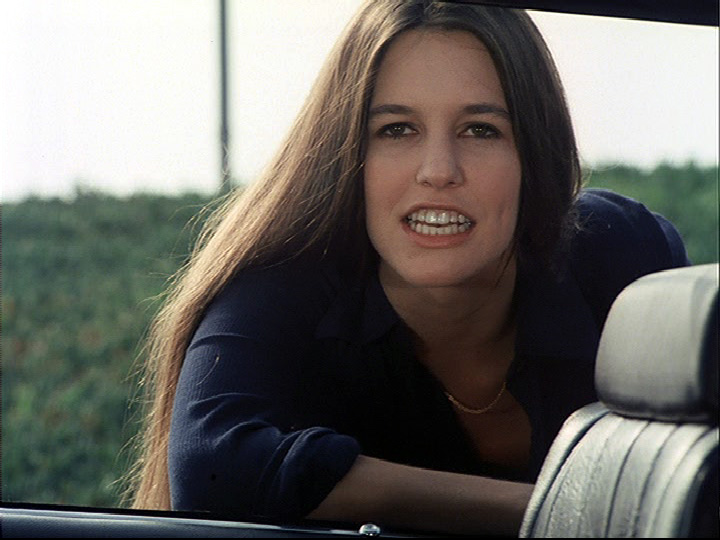 In
a brief career that lasted just over two years, she worked regularly,
appearing in the United Artists’ film Electra Glide in Blue and as
a Universal Studios “contract player,” guesting on the TV series The
Six-Million-Dollar Man, Kolchak:
The Night Stalker, Get Christie Love
and in a recurring role on Lucas Tanner.
In
a brief career that lasted just over two years, she worked regularly,
appearing in the United Artists’ film Electra Glide in Blue and as
a Universal Studios “contract player,” guesting on the TV series The
Six-Million-Dollar Man, Kolchak:
The Night Stalker, Get Christie Love
and in a recurring role on Lucas Tanner.
At
the beginning of 1975, Greene played the title role of Aura Lee Benton in
the classic Rockford Files episode “Aura Lee, Farewell.” It wasn’t
a huge role – her character was killed off about fifteen minutes into the
episode – but it was a substantial and memorable one. Her performance and
disappearance cast a shadow over the rest of the episode. After that,
Greene never acted again.
Thirty years later, she is a creative writing teacher contentedly living
in a lovely historic townhouse on the main drag of a small Pennsylvania
town. She is doing something she loves, “far more than acting,” she says.
She teaches women, children and teens how to tap into the creative
process, to love the art of writing, not to fear it. Her work helps
students take a break from perfectionism, trust their ideas, and reduce
tension and stress. Her business is called Write from the Heart.
“I
give my heart to people, just like an actor, except I do it in the
classroom and on the page,” she says.
Greene acknowledges that she was not ready - nor right - for the career
that she had pursued with such dedication. She was shy and deeply
uncomfortable “being watched by a camera.” She longed to live a more
contemplative life. It took her years to realize that she was stalking the
wrong talent.
“The real me is rather tender and poetic. I wasn’t ready to reveal that to
a camera, nor – do I think - would I ever have been. I was a writer – a
thinker - but, for years, I spent my energy on becoming famous. My parents
put high value on stardom, and I was up to my neck in their dream.
It’s corny - and sad - but I spent a lot of time believing how much they
would love me when they saw me up on that screen.”
Ironically, her parents were too caught up in their own Hollywood lives to
show her what roads to take, what pitfalls to avoid. Greene’s drive,
dedication and beauty was opening doors for her, but she wasn’t sure what
to do once she got inside.
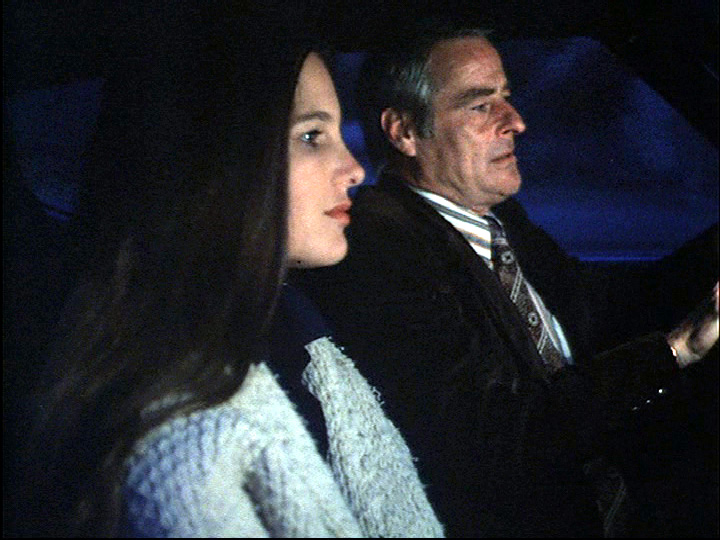 “In
retrospect, I didn’t know what I was doing,” she admits. “I had a lot of
nerve and talent, but I was untrained and I was doing it all for my
parents’ love. I didn’t want to open up to a camera – there was no love
there, but I couldn’t figure out where else it might be. For me, the set
was stressful and chaotic. I was 21, and already a very private person. I
didn’t belong in front of a bunch of strangers taking in my every move.
But, God, I was hell-bent. Nobody could stop me. It’s embarrassing, but I
was naïve, I fell for the Hollywood myth. I wanted to be Katherine
Hepburn, like every other girl in the world… and I truly believed I
could get there overnight! Meanwhile, I didn’t notice that, in reality, I
was doing incredibly well for an unknown.”
“In
retrospect, I didn’t know what I was doing,” she admits. “I had a lot of
nerve and talent, but I was untrained and I was doing it all for my
parents’ love. I didn’t want to open up to a camera – there was no love
there, but I couldn’t figure out where else it might be. For me, the set
was stressful and chaotic. I was 21, and already a very private person. I
didn’t belong in front of a bunch of strangers taking in my every move.
But, God, I was hell-bent. Nobody could stop me. It’s embarrassing, but I
was naïve, I fell for the Hollywood myth. I wanted to be Katherine
Hepburn, like every other girl in the world… and I truly believed I
could get there overnight! Meanwhile, I didn’t notice that, in reality, I
was doing incredibly well for an unknown.”
Today, she makes her living opening up to the world… through her love of
writing. “I teach people to relax, focus, pay attention to the world
around them. I’m particularly interested in supporting people who are
afraid, who have always longed to write, but think they can’t. They can,
if they’re taught with compassion,” she says.
Greene’s Pennsylvania home has few signs of her long-ago Hollywood
existence. One hall is lined with 8x10 glossies from the 1940s including a
picture of a five year old Melissa sitting by a pool with Johnny Carson,
next to one of her mother, laughing with Ginger Rogers, Lucille Ball and
Ann Miller on the set of Stagedoor. Next to that, her mother smiles
broadly, wearing a sarong and seated in a thatched hut amidst a line of
chorus girls in grass skirts. Another depicts her father in Palm Springs,
circa 1945, posing next to a Cadillac in shorts, cowboy boots and a pith
helmet. Below that is an autographed publicity close-up of her father,
which he gave to her as a Christmas present when she was in her teens. “He
signed it in the ‘60s but dated it 1940,” she says, “It reads ‘To my
darling daughter, Melissa, who won’t be born for 11 years. I love you,
Dad.’” She stares at the photo. “I’m the only person with autographed
photos of my parents,” she says, shaking her head and sighing. “My father
loved a good joke.”
Her birth as a writer is also with her in the home, best symbolized in the
form of 51 journals that she has kept since she was a young girl. “My
journals were a way to survive. They saw me through everything. When I was
younger, I believed they were worthless, filled with constant complaints.
As years went on, I saw them as a fascinating record, complaints and all.
Today, they help me make sense of my life, and give me endless ideas for
my writing. Journals are as essential as food.”
Greene’s first
movie role came by accident. She worked as a tour guide at NBC Studios
in the early 1970s. Several years later, walking out of a reading at
MGM for director George Cukor, who was casting Travels with My Aunt,
she ran into casting director, Mike Fenton, in the hall. When he asked
what she was doing there, Greene replied, boldly, that she was now an
actress. He told her he was casting a film called Electra Glide in
Blue with Robert Blake, and having a problem finding the female lead
– a Radcliffe hippie.
“I remember him
saying that they’d already seen Susan Sarandon, Katherine Ross, and
Sissy Spacek, but none of them were right. I was face-to-face with my
dream – ready… or not! It was completely surreal.”
Fenton sent her to
meet the director that afternoon. “I remember, Robert Blake was in the
interview. That never happens in Hollywood,” Greene explains.
“There I was. I didn’t know how to read. The script was terrifying to
me. I knew I was staring at “the big break,” and I was frozen. Rupert
Hitzig, the director, said, ‘Oh, just throw the script away. Just look
at him. Tell him to back off.’ So I looked at Bobby, and I was suddenly
overwhelmed with anger. And since I was a writer, I began to write the
script on the spot – I started calling him names and backed him into a
wall. I remember getting angrier and angrier at him because he was
acting and I couldn’t reach him, emotionally – the real Robert
Blake. The more he avoided me, the more exciting the script was that I
was writing in my mind.”
Greene was hired for
the role. The next day, she received a conference call from seven
casting directors at United Artists.
“They told me I had
been chosen to costar in this movie. They needed my address and phone
number and my social security number, I think, which all seemed rather
odd to me at the moment. Then they told me I needed an agent… fast. It
was fabulous and frightening, and it didn’t seem real,” she says. Her
father called the head of the William Morris Agency, and she was signed
the next day.
Little did she know, the film was already steeped in problems. It had
been written and was to be directed by newcomer, Rupert Hitzig – his own
first Hollywood break. The producer was another film novice, James
William Guercio, best known as the manager of the rock group Chicago. A
total unknown in the film world, Guercio saw opportunities to control
the direction of the film, and eventually had Hitzig removed from his
own project. Hitzig never had another big break in Hollywood. Guercio
became the director, while Blake and cast struggled to make a
first-class movie controlled by an amateur. Plunked down right in the
middle of the circus was Greene. 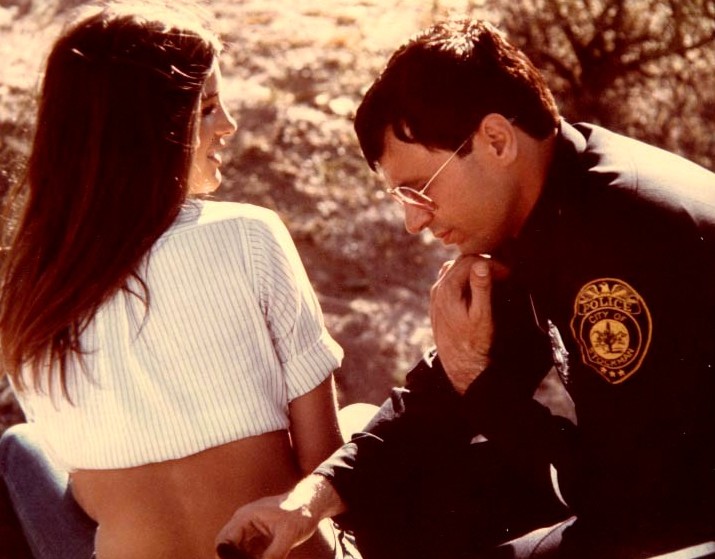
“From the first
rehearsal reading, there was distrust and confusion. Bobby was trying
to guide Guercio. To Guercio, the movie was just another toy. So here I
was around a table on Melrose Ave. with these Hollywood veterans: Bobby
Blake, Elisha Cooke, Mitchell Ryan and Billy Greenbush, and no director,
or source of support. I didn’t know how to act, nor did I really want
to, but I didn’t know that yet. I kept looking around that table
and thinking I was supposed to be on top of the world, but the truth
was: I was scared.”
The film was shot
on location in Scottsdale, Arizona. It was an odd mix of experienced
old-timers and newcomers who had never worked on a film in their lives.
This included Greene, as well as Peter Cetera and the group Chicago,
hired by Guercio for small roles as hippies living on a commune.
“Peter Cetera
played my boyfriend. He was great – so genuine. That’s when I first
began to see the kinship between musicians and writers - a very
different relationship than I was having with the actors. I couldn’t
relate to the actors at all, but I didn’t understand why
because I was supposed to be one. I saw Peter Cetera years later,
and the first thing I did was thank him for being real.”
Legendary cameraman Conrad Hall was the cinematographer, and much of the
crew had recently worked with him on Butch Cassidy and The Sundance
Kid. There was also wardrobe designer Rita Riggs who later designed
the costumes for An Officer and a Gentleman. And photographer
Phil Stern, who had helped make legends of every major star in
Hollywood. But even their talents and experience couldn’t undo the
turmoil swirling behind the scenes of the film.
“Hollywood was
turning a corner in the early 1970s,” Greene says, “Unknowns like
Guercio were stepping into the business with money, but no experience,
hobnobbing with the best. Electra Glide was a film out of
control. The power games eclipsed everything. We were all caught up in
it. If you look at the film now, you’ll see that the first half doesn’t
look at all like the second. The first half was shot by Conrad Hall;
the second was done later by a half-ass second unit. It was a mess.”
From the first
rehearsal reading, Greene was intimidated by her temperamental co-star,
Blake. “I didn’t know how to be an actress. I was 23 and I was
sensitive and overwhelmed. The problem was: I liked Robert right
away. I wanted to know him, to
experience who he really was - but I was terrified by him. He was
erratic and intense and he was ‘on’ which overwhelmed me. Today, I
realize he was struggling, just like me.”
Of
course, in the years since, Blake’s temper has become common knowledge
when, in 2001, his wife Bonnie Bakley, was found shot to death in
Blake’s car. According to Blake, he had left her sitting alone in the
car, in front of a restaurant where they had just had dinner. Blake was
indicted for the murder but eventually found Not Guilty due to a lack of
evidence. However, the court fight and the continued doubt about his
innocence have played havoc with his career.
“We did a half-nude love scene in the front seat of a car. I think we
made-out for about ten takes. By the time we
climbed into the back, we had most of our clothes off. The crew had
fogged the windows, and I remember Bobby lying next to me in his jockey
shorts, laughing and telling me jokes to help me relax. We drew pictures
on the foggy glass with our feet. In retrospect, he understood my fear.
There were moments when he was protective and sweet, but there were
others when he became incredibly dark. The whole experience was dark,
except at moments when I made him laugh. After it ended, our lives
diverged and I never saw him again.”
When the news of the murder came forward, Greene says she was confused.
“For years, I blamed Robert for what happened to me on Electra
Glide. But, seeing him in the courtroom, I found myself thinking
more about his delicacy - his sweetness - than his volatility. In my
heart, I still can’t link him to the crime. Whatever happened, he was a
sitting duck, because he’s known to be moody - he plays those
characters. But he wears a mask. It’s understandable; he was abandoned
as a child. He was lonely during Electra Glide, and I felt
compassion for him, because he seemed like someone who’d been thrown
into too large a world at a young age – like me. Whatever the truth is,
he’s suffered, and I feel deeply sorry for him.”
Greene got her first lesson in the cruelty of Hollywood when, months
after shooting ended, she went to the preview screening of Electra
Glide in Blue. Sitting in the back of the dark theatre, she
realized that she had been edited out: from female lead to two lines.
To add insult to injury, her name was misspelled in the credits.
“I
was devastated,” she says. “That’s a story in itself. But Hollywood rolls
right on. Suddenly, my agents were very hard to get on the phone.”
Nevertheless, she pressed on. In 1973, she interviewed at Samuel Goldwyn
Studios with writer/director, Michael Cimino - winner of the Academy Award
for Best Picture for The Deer Hunter, and also the man behind the
legendary flop, Heaven’s Gate. Cimino was directing the Clint
Eastwood movie Thunderbolt and Lightfoot and needed an actress who
could also ride a motorcycle in one scene. ‘Nooo problem,’ I told him…
though I’d never been on a motorcycle in my life!” Greene says.
She convinced Cimino to meet her on the back lot in two weeks, then called
stunt-man friend Bud Ekins, for lessons. Ekins was Steve McQueen’s double
in The Great Escape and stunt coordinator for Electra Glide in
Blue. Within weeks, Greene could handle both a Honda and a Harley.
When she and Cimino met, two weeks later, she rode like a pro. Cimino was
impressed.
“But, before he’d give me the part, he asked me to ride up the hill and
back down, one more time,” Greene remembers. “I was so overstimulated. I
came down the hill, and forgot where the brake was. I crashed into a pile
of steel dollies, and broke both bones out of my lower leg. Bud Ekins laid
across me while they cut my boot off. After surgery, that day, I looked up
and the nurse asked me if I knew Clint Eastwood. It was crazy. I was in a
cast for five months.”
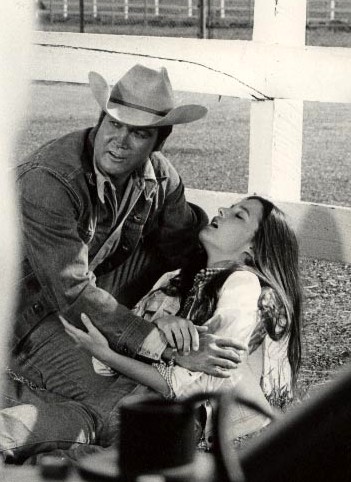 When
the cast came off, she hit the streets again. Again, she got lucky. Her
promotional savvy landed her a contract with Universal Studios, and
secured her a place in the dying tradition of old Hollywood: the studio
system. In the 1930s and 40s, MGM, Warner Brothers and 20th
Century Fox kept a stable of actors and actresses under standard seven
year contracts. They worked exclusively on that studio’s films, while
being “groomed” for stardom. By the 70s, this kind of agreement was
becoming outdated, but Greene was one of the last actors to sign such a
deal, along with Lindsay Wagner, Randy Mantooth, Susan St. James and
Harrison Ford.
When
the cast came off, she hit the streets again. Again, she got lucky. Her
promotional savvy landed her a contract with Universal Studios, and
secured her a place in the dying tradition of old Hollywood: the studio
system. In the 1930s and 40s, MGM, Warner Brothers and 20th
Century Fox kept a stable of actors and actresses under standard seven
year contracts. They worked exclusively on that studio’s films, while
being “groomed” for stardom. By the 70s, this kind of agreement was
becoming outdated, but Greene was one of the last actors to sign such a
deal, along with Lindsay Wagner, Randy Mantooth, Susan St. James and
Harrison Ford.
“I
talked my way into a reading for Monique James, the head of Universal’s
New Talent Department. Those were the days when actors actually read
for producers, before producer’s required a video of the actor’s work,
beforehand. I remember the scene I chose. It was extremely funny, and the
casting director wrote a little note ‘could do comedy very well.’” Greene
still feels that she would have been better suited as a comic than a
serious actress, “but because I looked like I did, that’s not what they
hired me for. I had to be a face. I had to be sexy. Which – thankfully and
quite consciously, I may add – was not in my job description when I
created Write from the Heart!” she laughs.
Greene’s first role with Universal was the lead guest starring role of an
episode of the then red-hot series The Six Million Dollar Man with
Lee Majors. Greene knew the producer Harve Bennett, who went on to produce
several of the Star Trek movies. Bennett had campaigned for her
studio contract. “I had a way of getting people riled up - I think I was
Mickey Rooney in a former life: ‘Hey, let’s have a show!’ At that time,
enthusiasm went over really big in Hollywood. That’s how my father made it
into RKO. In those days, if you had a head of steam and a lot of guts –
boy - you could get far.”
Bennett
was so excited about her prospects that he sent her a telegram that read:
“Good luck! I’d say ‘break a leg,’ but you just might do it!” and then
gave her a bigger screen credit than star Lee Majors. She remembers
feeling overwhelmed by the pressure.
“I
didn’t know what I was doing, pure and simple. And I was scared to death
of failing. Lee Majors was great. I’ll never forget him taking me by the
shoulders and moving me out of the way for his close-ups. Contrary
to my dream, I didn’t exactly shine. At the screening, Harve said, ‘You
didn’t have too much fun doing that, did you?’ which has always haunted
me. Afterwards, all I remember my father saying was ‘You looked nervous.’
And my grandmother writing me this note from Miami that said ‘Darling, you
were wonderful, but… next time, speak up!’ I didn’t look at the show for
30 years.”
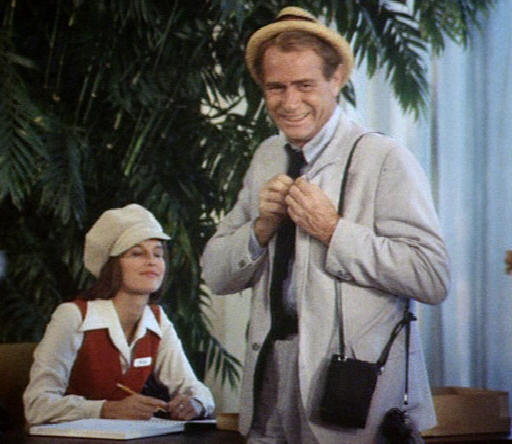 Still,
she kept plugging away, appearing in six Universal series in under a
year: the lead female guest star in an episode of Get Christie Love
with Teresa Graves, a recurring role in two episodes of Lucas
Tanner (starring future Good Morning
America host
David Hartman), and a small part on Kolchak: the Night Stalker with
Darren McGavin. She even had the opportunity for her own series – a show
about Canadian Mounties in which she screen tested with a then
mostly-unknown carpenter-turned-actor named Harrison Ford and Randy
Mantooth, who had just starred in the popular but short-lived series
Emergency! The series never made it on the air.
Still,
she kept plugging away, appearing in six Universal series in under a
year: the lead female guest star in an episode of Get Christie Love
with Teresa Graves, a recurring role in two episodes of Lucas
Tanner (starring future Good Morning
America host
David Hartman), and a small part on Kolchak: the Night Stalker with
Darren McGavin. She even had the opportunity for her own series – a show
about Canadian Mounties in which she screen tested with a then
mostly-unknown carpenter-turned-actor named Harrison Ford and Randy
Mantooth, who had just starred in the popular but short-lived series
Emergency! The series never made it on the air.
By
the time she got the Rockford Files role, Greene was starting to
reconsider her career. “I approached everything with a writer’s mind, and
that was death, because I was watching the scene I was in, not
living it - analyzing it in my mind, instead of really being there. I
wasn’t an actress, I was writing a script for an actress.”
Nevertheless, her Rockford Files episode was a success, and she
remembers the experience fondly. “Rockford was the most successful
thing I did. First of all, I was playing a poetic - and sensitive - free
spirit. No wonder I was at home!” she laughs. “It’s interesting that the
show was directed by one of Hollywood’s greatest child stars, Jackie
Cooper. He was tough, but he was also
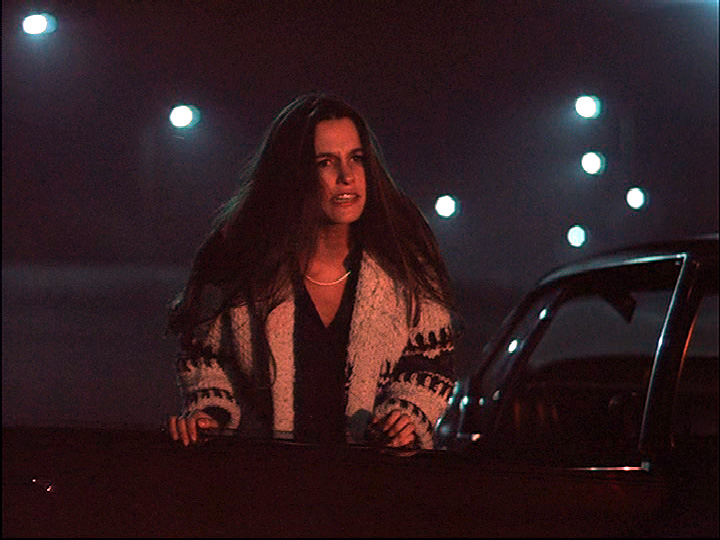 rock-bottom sure – totally
confident. Jackie was lying in the back seat of the car during my scene
after Robert Webber picks me up, hitchhiking. The camera was on the side
of the car. So it was just the three of us there – not a whole crew - and
I was able to relax.”
rock-bottom sure – totally
confident. Jackie was lying in the back seat of the car during my scene
after Robert Webber picks me up, hitchhiking. The camera was on the side
of the car. So it was just the three of us there – not a whole crew - and
I was able to relax.”
“The
scene where we hit the man in the road at night? I kind of liked myself in
that scene - I really looked scared. But scared was kind of
easy for me, you know!” she laughs. “There’s also a scene that I love:
we’ve hit the man,
and
we stop at this shack for Robert to make a phone call for help. He’s
dialing the phone frantically. We’ve just spent the night together, and I
look at him and realize it was just another fling. There’s a sadness and
depth in my eyes… a whole lot more in that look than you usually see in an
Universal TV show. It was the first time I saw the true me, onscreen. I’m
still proud of it.”
More roles came her way. However, by this time, Greene had had enough. She
decided that perhaps acting wasn’t for her after all. “The problem was I
didn’t believe in myself, because I wasn’t
being myself. I thought I’d find love, that people would see me on
the screen and be amazed. I now realize that I wanted them to see the
person I’ve become all these
years later. Anyone
will tell you now; I’m a very gentle, private person who doesn’t like to
be onstage. In retrospect, I think a few people at Universal got a glimpse
of the real me – Harve Bennett, Billy Wilder, Dick Levinson who produced
Murder She Wrote. They were highly intelligent, wonderful
people – writers themselves - and they recognized my intellectual spark.
But supportive friends and big breaks mean nothing unless you love
what you’re doing.”
When she finally made the decision to leave the business, she simply
stopped going on interviews, and eventually cancelled her contract with
William Morris. “It was clear,” she says, “I was having dreams that the
studio was in flames. I was in agony trying to be someone I wasn’t.”
For awhile, Greene went into modeling. In the mid 1970s, she broke into
advertising copywriting and
worked for Campbell
Ewald Advertising, in Detroit. She returned to Los Angeles to write and
produce Previews of Coming Attractions for the movies.
In
1980, she married a paintings conservator and moved east to Boston,
then to Williamstown, Massachusetts, where her husband worked at The
Sterling & Francine Clark Art Museum. It was a shock to go from Hollywood
glitz to a more sedate academic lifestyle, but Greene soon felt at home.
“It was like food for the starved. It was a huge opening to a world that I
wish I’d had more of, before Hollywood struck. I started writing serious
short stories, connected with faculty at Williams College, and luckily met
Jim Shepard, a fiction and film professor. He was the first person to
recognize my gift, to read my stories and urge me to keep writing. He
recommended my work to The New Yorker and The Atlantic
Monthly, and we’re friends to this day. Jim was funny and
compassionate in the classroom, and his teaching style inspired my own.”
Greene wrote fiction, full-time, for several years, and continued her
journals, in earnest. In 1983, her first published short story appeared in
The Northwest Review, a literary journal from the University of
Oregon, and her poetry was also published.
During those years, she also began a serious songwriting collaboration
with pianist, arranger and composer, Lincoln Mayorga. Greene and Mayorga
met in 1970 when she was a tour guide at NBC and he was playing piano in
the orchestra on The Andy Williams Show. Mayorga moved East in the
early 90s, and the two became reacquainted after twenty years. They wrote
steadily together for five years for the sheer joy of it. Their songs were
performed by Michael Feinstein and Andrea Marcovicci, and recorded by a
group of Hollywood’s most illustrious back-up singers, The Power of Seven.
“It was one of the happiest, most creative five years of my life. Lincoln
and I were a force, because we were creating for ourselves, and nobody
else. We were doing it for love, not fame, and this was a revelation to
me, a real change in my values. We tapped into a certain truth.”
At
the same time, she began a quiet but highly personal endeavor: teaching
creative writing to senior citizens, with a particular interest in helping
even the most crippled to flower. “I didn’t know it, but I’d cracked the
door open to my future,” she says.
Meanwhile, Greene’s marriage came to an end. And so did the writing “…for
about six years of grueling, non-stop survival.”
Over the next six years, she went into partnership with a well-known
Americana and
Folk Art Antiques dealer. Using his knowledge and her promotional
abilities, they built a million dollar business in a restored 19th
century church in Great Barrington, Massachusetts. The business came to an
abrupt end in 2000 when her partner suddenly left – “A precipice I would
not recommend looking over, if you can help it,” she says - and Greene
decided to move to Pennsylvania to reinvent herself, once again.
“I
was visiting a friend, and I walked down this street and saw this
beautiful house, and it was sort of like; okay, get everybody away from
me. I don’t want restaurants. I don’t want clothes. I don’t want to worry
about what I’m looking like. I just want to move here and be quiet and get
back to my writing. It was a leap of faith.”
To
make ends meet, she took a job in an office park. “I took a corporate job
for two months, writing business newsletters. It almost killed me. While I
was there, 9/11 hit. I remember I was in the conference room. I watched
those planes tear into those buildings, and… I looked around me… and I was
surrounded by strangers, in a strange job, in this totally strange town
outside Philadelphia, Pennsylvania, and – a few days after that - I was
driving home, and I heard this
little voice in me
whisper, ‘Melissa, you’re a poet.’ I quit the job, and I was suddenly out
of work in this huge house, all alone. A few weeks later I remembered one
of the dear ladies in the nursing home, back in the 80s, and I had this
vision to teach writing, but to teach it from the gut, with empathy and
compassion.”
Her vision was Write from the Heart, a series of creative writing
workshops for women, children, teens, which she began in 2001 with a group
of 15 women. She has since taught hundreds. “Suddenly, my dream became
clear,” she says, “to open people’s hearts, to help them discover the joys
of writing, without being afraid. To help them over the same
self-consciousness that I’d felt while being scrutinized by a camera.”
Today, she offers year-round classes for women, as well as weekly workshops
and summer camps for children and teens. Her classes draw students from as
far away as Boston and Washington D.C. They range from young adults to
senior citizens; business women and homemakers. She also works in
conjunction with a hospice grief program, local schools, and therapy
counseling groups.
“Creative writing is a therapeutic tool. It can console, illuminate, and
heal. It can also be one hell of a lot of fun! My goal is: to teach a few
simple writing basics in an atmosphere of integrity, kindness and warmth.
Oh, yes, and we laugh a lot! I try to create a safe, gentle place where
women can be themselves. Even during my acting days, I was fascinated with
touching people’s feelings… but with understatement and subtlety. Part of
my problem was: Hollywood didn’t value subtlety, nor did it value decency
and respect. I was living in duplicity and glitz, but I always kept
my eye on decency and respect.”
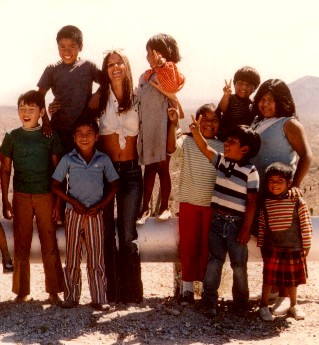 Because of the years that she was distracted from
her own writing career, she is particularly interested in
“reacquainting”
women with their creativity, especially those who
have put their writing lives on pause because of divorce, children, or
career.
Because of the years that she was distracted from
her own writing career, she is particularly interested in
“reacquainting”
women with their creativity, especially those who
have put their writing lives on pause because of divorce, children, or
career.
“My goal has been to help women slow down, take a
breath, and find a deeper understanding of their lives and writing.
Everyone has an imagination. They may just not know how to get in touch
with it… or they may have simply been pointed in the wrong direction.”
Her students come from all over to enjoy her
insights, compassion, and wit. “What I do is hard to describe. Mischief
helps. Also irreverence. One thing I do: I share objects with people -
things that turn my senses on - because writing is all about the senses: what things smell, taste, feel and
sound like. I bring in feathers to touch, and fish food to smell, and
these little miniature hangers that bring out the most amazing stories in
people that, half the time, have nothing to do with miniature hangers!”
She laughs. “And – voila! – suddenly, we’re writing! But the key word is
compassion.”
Now,
more than thirty years after her short-lived quest for Hollywood glory,
Melissa Greene shows two pictures. One of them as a young woman on the
set of Electra Glide in Blue, standing in the middle of a group of
Mexican schoolchildren who were extras in the film. The second shows her
today, surrounded
by children from one of her summer camps. Three decades of experience 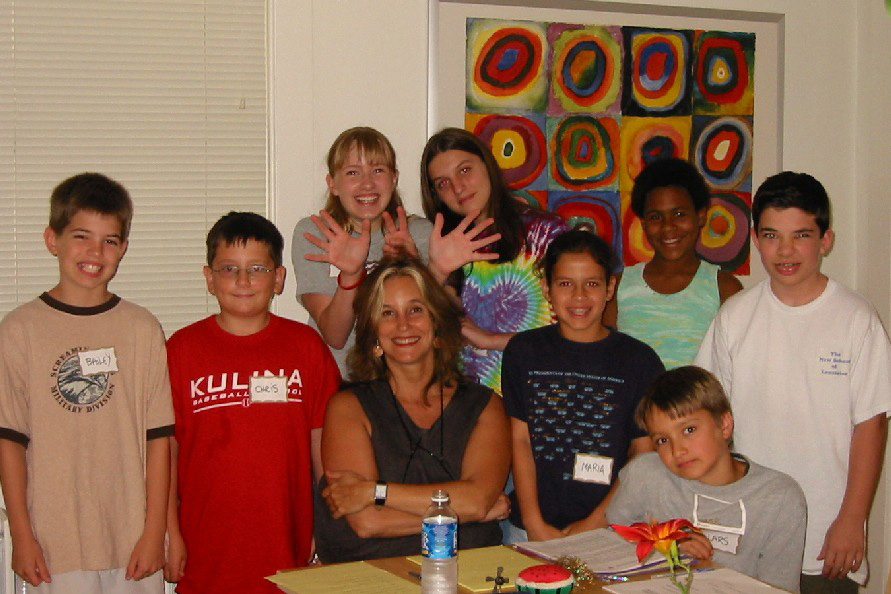 have
definitely made some changes, but what is most striking is how little -
really - has changed. Melissa Greene has come a long way to end up in a
surprisingly similar place – one of excitement,
beauty and creativity - but a place far more comfortable than Hollywood: a
peaceful place within her own heart.
have
definitely made some changes, but what is most striking is how little -
really - has changed. Melissa Greene has come a long way to end up in a
surprisingly similar place – one of excitement,
beauty and creativity - but a place far more comfortable than Hollywood: a
peaceful place within her own heart.
“I
don’t think it’s a coincidence I found my way back to a small town,”
Greene says. “I grew up in Encino, California, which was a small town in
the 1950s, before it became the brunt of suburban jokes. The Pennsylvania
countryside reminds me of the Valley, when the land was still pure, though
the culture here is the complete opposite. That’s what I needed though. I
needed to see the real world, going about its daily business, the world
I’d missed.
“In essence, I came here to heal. And Write from the Heart was born from,
and during, that period of healing. I wanted to use my grief from being
separated from my writing… and myself… to help others. In the
process, I’ve become whole.”
And so, Greene has accomplished at least part of her happy ending. She
is happy to be hard at work
making her workshops a safe haven for writers. “This is the class that I,
personally, would have wanted to go to all those years back. Hey, but
since I teach it, I guess I get to go to it now,” she
laughs, “so, you see, we’re all benefiting!”
She is also working on her memoir. “Gee, I wonder what it’s about?!” she
smiles.
Most of the people in Greene’s world know little about her Hollywood past,
though this seems to be changing. “I’ve just never talked about it. First
of all – I mean - you don’t just sit down in front of your friends and
say, ‘Hey, you know what? I was on The Rockford Files,’” she
quips. “Though, lately, I’ve become looser about it. Sometimes, I’ll free
write in class about my parents, which can
lead to everything from a description of my mother’s cigarette holder to
my father singing ‘Stars Fell on Alabama’ at the top of his lungs at 12:00
a.m. on a school night. My Hollywood upbringing is obviously a huge
subject for me. And that’s exactly what I teach people to find: their
own deepest, most important subject, that one topic that they - truly,
deep down - want to write about.”
When asked how she feels about life-after-Hollywood, Greene grows wistful.
“I’ve always wondered what those years were about. Yet, without them, I
might not have explored my creative potential. They set a tone for my
creative life, a standard I’m still reaching for. And if it hadn’t been
for my Universal days, I also wouldn’t have known how to market myself,
which has helped me to create and sustain Write from the Heart. Though,
let me tell you: it’s
much easier to market someone you love, than someone you don’t!”
she smiles.
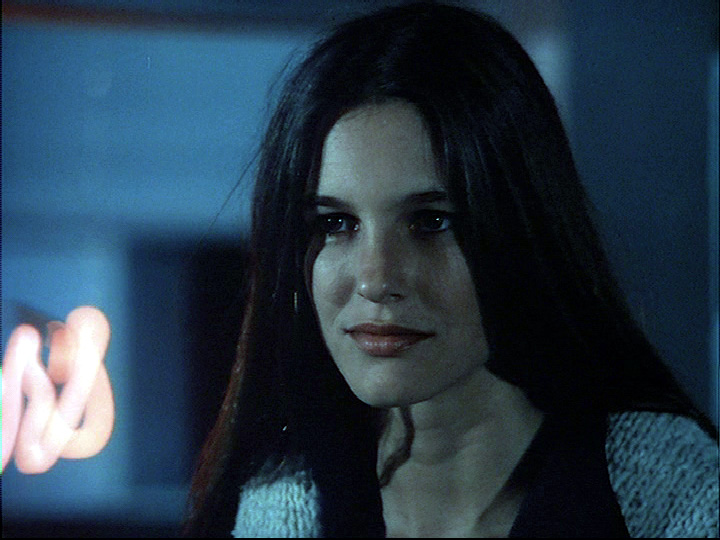 Then
she becomes reflective again. “Looking back, I was young, and knew nothing
but Hollywood, and I kept looking
over the tops of my deepest dreams, wanting more and more. That’s what
Hollywood does: it promises you everything - too much - until
you’re glutted with fantasy and bravado and a perverse sense of
entitlement. And you’re totally blinded, spiritually. I thought the answer
was somewhere outside myself - can you believe it? And on TV, of
all places! I didn’t realize that I was more than just a face, or that my
dream was within reach, right here inside me. I couldn’t see that I would,
ultimately, flower from humility, not glamour. I didn’t know it,
but what I really longed for was to bring out the truth and soul in
people. I see a bit of that longing in my eyes, during that last scene in
The Rockford Files, the one when
I take a last look at Robert Webber. That look is worth a million dollars
to me now; a little reminder that ‘I’ was there all the time.”
Then
she becomes reflective again. “Looking back, I was young, and knew nothing
but Hollywood, and I kept looking
over the tops of my deepest dreams, wanting more and more. That’s what
Hollywood does: it promises you everything - too much - until
you’re glutted with fantasy and bravado and a perverse sense of
entitlement. And you’re totally blinded, spiritually. I thought the answer
was somewhere outside myself - can you believe it? And on TV, of
all places! I didn’t realize that I was more than just a face, or that my
dream was within reach, right here inside me. I couldn’t see that I would,
ultimately, flower from humility, not glamour. I didn’t know it,
but what I really longed for was to bring out the truth and soul in
people. I see a bit of that longing in my eyes, during that last scene in
The Rockford Files, the one when
I take a last look at Robert Webber. That look is worth a million dollars
to me now; a little reminder that ‘I’ was there all the time.”
She ponders this, then smiles. “I keep this little haiku on my desk. I’ve
carried it with me since I was twenty years old. It reads “In my dark
winter / lying ill / at last I ask
/ how fares my neighbor?” I’m proud to
have lived an unusual life. I‘m proud to have wandered off the beaten
path. But I’m proudest of creating my own path: guiding people
who are lost, lonely and creatively blocked toward freer, happier lives.
All my life I wanted to touch people - to draw them out of themselves with
humor and warmth, to make an intimate connection. And here I am – far
beyond Hollywood, in
this sweet little town in Pennsylvania - living my dream.”
For more information on
Melissa Greene and Write from the Heart, please visit
www.writefromtheheart.us